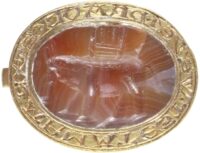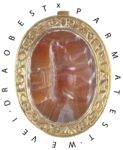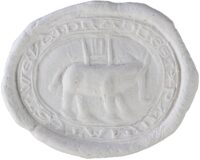 An extremely rare medieval gold seal engraved with the image of an elephant carrying a castle on its back has been discovered in Norfolk. It was discovered in June 2020 by a metal detectorist near King’s Lynn. The seal dates to between 1250 and 1350 and is only the third gold seal ever recorded by the Portable Antiquities Scheme, and the only one to star an elephant.
An extremely rare medieval gold seal engraved with the image of an elephant carrying a castle on its back has been discovered in Norfolk. It was discovered in June 2020 by a metal detectorist near King’s Lynn. The seal dates to between 1250 and 1350 and is only the third gold seal ever recorded by the Portable Antiquities Scheme, and the only one to star an elephant.
“Few people in medieval England would have seen a live elephant,” said Beverley Nenk, curator of later medieval collections at the British Museum.
“The image may have been based on reports of these fabulous and exotic creatures from travellers or pilgrims returning from the East or from the Crusades, or from descriptions and images in bestiaries and other manuscripts.”
There was a live elephant in the royal menagerie at the Tower of London between 1255 and 1257 – a gift from King Louis IX of France to King Henry III.
The seal is just over an inch long, a gold oval set with an oval stone intaglio stone engraved with an elephant in profile walking towards the right, its trunk curled forward at the tip. On his back is a castle (an adaptation of the howdah, the canopied seat carried by Asian war elephants). The stone is probably a carnelian, although there is some slight banding like you see in agate. It is backed and rimmed in gold and there is a gold loop soldered to the reverse.
 There is no name on the seal (the other gold seals are also anonymous), but there is an inscription. It reads: PARMAT EST ‧ WEVEI ‧ DRA OBEST, a bit of an obscure saying which is being interpreted as meaning “armed with a shield, the outlaw dragon is harmful.” The connection between the castled elephant and the inscription is equally obscure. It could be a reference to the idea, commonly expressed in medieval bestiaries, that dragons were elephants’ only natural enemies.
There is no name on the seal (the other gold seals are also anonymous), but there is an inscription. It reads: PARMAT EST ‧ WEVEI ‧ DRA OBEST, a bit of an obscure saying which is being interpreted as meaning “armed with a shield, the outlaw dragon is harmful.” The connection between the castled elephant and the inscription is equally obscure. It could be a reference to the idea, commonly expressed in medieval bestiaries, that dragons were elephants’ only natural enemies.
In medieval heraldry, elephants symbolized power, wisdom and courage. Because they were associated with Eastern rulers, elephants on a coat of arms could refer to a victory or success in the East. The castle on the back is associated with royalty and combat. Christian iconography used the elephant as a symbol of Christ’s redemption of fallen humanity.
 The date range is suggested by the lettering, which is 13th century in style, and by comparison to other seal matrices set with gemstones that were created in the early 14th century. It is not clear if the intaglio itself is medieval. It could just as easily be ancient, as ancient engraved gemstones were reused in seals and jewelry in the Middle Ages.
The date range is suggested by the lettering, which is 13th century in style, and by comparison to other seal matrices set with gemstones that were created in the early 14th century. It is not clear if the intaglio itself is medieval. It could just as easily be ancient, as ancient engraved gemstones were reused in seals and jewelry in the Middle Ages.
The seal’s status under the Treasure Act 1996 will be determined at a coroner’s inquest at the end of the month. As it is made of more than 10% precious metal and is more than 300 years old, the will certainly be declared official Treasure, after which a British Museum committee of experts will assess its market value. Local museums will be given first crack at the chance to pay the fee (split by the finder and landowner). The Norwich Castle Museum has already expressed a desire to acquire it when it becomes available.